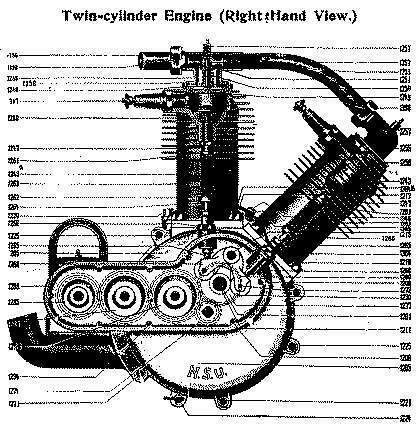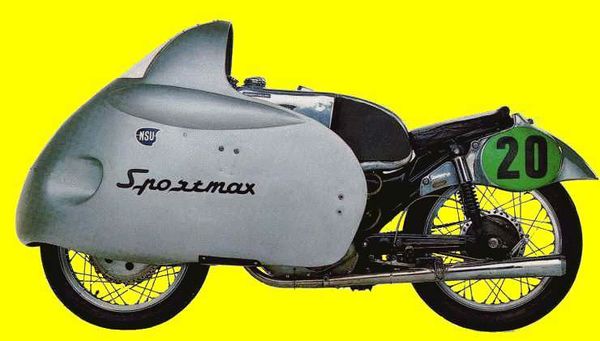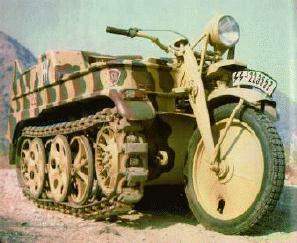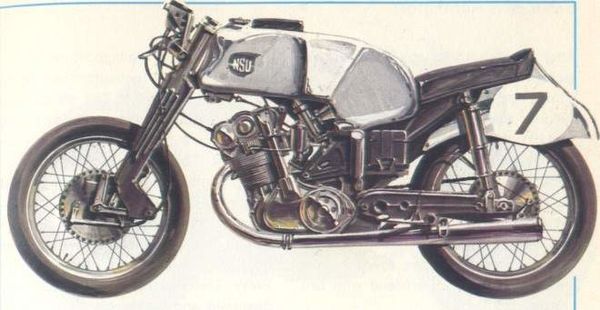NSU 250 Rennmax & 250 Twin
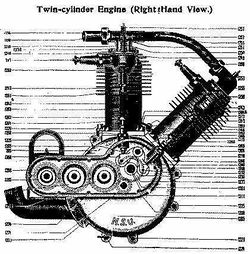 |
|
| NSU 250 Rennmax & 250 Twin | |
| Manufacturer | |
|---|---|
| Weight | |
| Manuals | Service Manual |
Photos[edit | edit source]
Overview[edit | edit source]
NSU 250
NSU Rennmax 250 1954
The Rennmax 250, like the Rennfox 125, made its debut in 1952.
Although it did not win any world championship race that year, it nonetheless
had all the qualities that were needed to stand up against the Moto Guzzis
ridden by Lorenzetti and Fergus Anderson.
In 1953 Werner Haas won both the 125-class and the 250-class championships with
NSUs. This was a surprise upset, because at the beginning of the season the
Italian vehicles were the favorites.
The Rennmax that Haas rode in 1953 was a four-stroke,
two-cylinder two-wheeler developed from the prewar supercharged 500. It had
two-shaft overhead distribution with bevel gears. The engine generated 30 h.p.
at 10,500 r.p.m.
Although the Rennmax proved to be slightly better in performance than competing
motorcycles in its class, it was completely overhauled in 1954. The distribution
was redesigned to operate by a single shaft acting on the axis of the intake
cam. The transmission was given a sixth speed, and the bore and stroke were
readjusted.
Haas rode the 1954 Rennmax 250 to victory in all the races he
entered. He won his second world championship with the Rennmax. Even when NSU
announced its retirement from racing the following year, it seemed clear that
the Rennmax would continue to lead the field for some time.
Motorcycle: NSU Rennmax 250
Manufacturer: NSU, Neckarsulm
Type: Racing
Year: 1954
Engine: NSU two-cylinder, four-stroke, with double overhead distribution, two
shafts with bevel gears. Displacement: 249.3 cc. (55.9 mm. x 50.8 mm.)
Cooling: Air
Transmission: Six-speed block
Power: 39 h.p. at 11,500 r.p.m.
Maximum speed: 135
m.p.h. (with bell fairing)
Chassis: Single-bar stamped plate, engine suspended and projecting.
Front wheel:
swinging-link suspension;
Rear wheel: telescopic
Brakes: Front and rear, central drum with double cam
NSU 250 Twin 1954
1954 NSU. 250 TWIN. In the twenties it was not uncommon for a
T.T. race average to be boosted by a few m.p.h. from one year to the next. But
it was virtually unprecedented in modern times when, in 1954, Werner Haas hurled
his twin-cylinder N.S.U. round three laps of the Mountain course to record the
first "over-90" win in the Lightweight race, for his record average speed of
9088 was over 6 m.p.h. faster than Fergus Anderson's 1953 record speed of 8473
m.p.h.
Undoubtedly a star part in this dramatic victory was played by the machine which
Haas rode.
The N.S.U. factory had raced twins in 1953, but they had
certain shortcomings, to overcome which the unit was virtually redesigned in the
winter of that year. The race average shows how well the bugs were eradicated.
Apart from such obvious aids to high-speed work as twin-leading-shoe' brakes at
front and rear, the machine was surprisingly similar to the roadster N.S.U.
"Max" as far as frame and forks were concerned. There the similarity ended.
Unit construction was employed for the parallel-twin engine
and gearbox, which had no fewer than six ratios. Primary transmission was by a
pair of spur gears (so the engine ran "backWards"). Both cylinder barrels were
deeply spigoted into the crankcase and a cross-shaft in the "top" of the
crankcase drove the distributor via skew gears and the bottom bevels of the
vertical shaft drive to the twin. o.h. This shaft drove to the inlet end of the
camshaft gear train, so that any backlash in the system would have ininimal
effect on the induction.
The factory claimed an output of 42 b.h.p.as much as most 1961 "350s"!
SPECIFICATION
Engine: inclined parallel twin 250 c.c. d.o.h.c; drive to
camshafts by shaft and bevels. Ignition: coil and distributor.
Transmission: gear primary drive to unit-construction six-speed gearbox; final
drive by chain.
Frame: welded pressed-steel spine; pivoring-fork rear suspension.
Forks: leading link.
The Rise and Fall of the NSU Empire
From Knitting Machines to World Championships and Finally,
Obscurity
By Dave Tharp, Virtual Museum Curator
Lightweight street motorcycles just never caught on in the
Americas -- except for a brief time in the late 1960s when you could meet "the
nicest people on a Honda." However, in Europe, bikes displacing under 500cc have
always been the workhorses, providing economical transportation, serious sport
and touring capabilities, and even towing sidecars.
In 1910, NSU set a US coast-to-coast "cannonball" speed record.
Because of this big-bike myopia, many riders have consistently overlooked the excellent European lightweights, including the NSU -- arguably the best of them all.
At the turn of the 19th century, the small factory town of Neckarsulm, in southern Germany, was the home of a company that manufactured automatic knitting machines as well as a successful line of "safety" bicycles (bicycles with two small wheels and a chain drive, as opposed to the "penny-farthing" big-wheeled types). This company went by Neckarsulm Strickmaschinen Union (Neckarsulm Knitting-machine Union), a name that described their business accurately enough, but is quite a mouthful for the non-Germanic. Hence, they eventually adopted the initials NSU.
Before the name change, their bicycle subsidiary's name -- Neckarsulmer Fahrradwerke -- was just as difficult to pronounce, but it did appear on the tanks of their first motorcycles. These appeared in 1901 (two years before the first Harley-Davidson), and consisted of a 1.5 HP Swiss-built Zedel engine (another copy of the DeDion-Buton) clip-mounted on the downtube next to the crank assembly of one of their standard bicycles. Final drive was accomplished via a flat leather belt that connect a pulley on the crankshaft to a pulley on the rear wheel.
Not satisfied with the Zedel, NSU introduced their own singles and V-twins in 1903. This rapid pace of development continued, and the factory introduced a liquid-cooled single in 1905, and a revolutionary swing-arm rear suspension motorcycle in 1914 (still belt-drive, though).
The NSU V-Twin engine, circa 1905. Note the "atmospheric" intake valves, opened by the suction of the piston going down. Photo by W. Conway Link, Deutsches Motorrad Register.
During this period, racing success for the NSU factory led to fame and a greatly-increased export market. It's likely that the unpronounceable name lead to the reduction of the tank emblem to the initials "NSU," or perhaps there was a paint shortage.
NSU was heavily involved in war production during W.W.I. After the-war-to-end-all-wars, demand was very high for motorcycles and they responded with a wide range of models. These included sidevalve and OHC 250's, sidevalve 500 singles, and V-twins of 500, 750, and 1000cc displacements.
In 1929, NSU hired Walter William Moore away from Norton, where he had recently completed the design of the CS1, a towershaft-driven OHC 500cc single (also known as a "bevel drive," as in bevel-drive Ducatis -- a bevel gear on the crankshaft drives another bevel gear on a driveshaft that parallels the cylinder. At the top of the cylinder, another bevel gear drives a fourth bevel gear on the overhead camshaft), the forerunner of the fabulous Norton Manx. By 1931, NSU was producing excellent towershaft-driven OHC singles that were highly successful. NSU became one of the largest producers of motorcycles in the world in the 1930s. Starting in 1937, Moore and Albert Roeder designed supercharged DOHC GP twins in 350cc and 500cc flavors. These bikes were unsuccessful before the war due to reliability problems, but performed well after the war when the bugs were worked out.
Unlike the Allies, the German Army had a great deal of faith in motorcycles as weapons of war. Motorized rifle regiments equipped with heavy BMW and Zundapp sidecar rigs were present in every armored division. Meanwhile, NSU produced one of the weirdest military vehicles ever conceived.
The Sd. Kfz 2 Kleines Kettenkraftrad half-track-- Who thought this up, anyway?
The Sd. Kfz 2 Kleines Kettenkraftrad (Small-Tracked Motorcycle) was a light armored vehicle with the front end of a motorcycle attached to the rear end of a half-track. The handlebars operated differential brakes on the tracks as well as turning the front wheel. Powered by an 1500cc 4-cylinder Opel engine, it was produced by the thousands to equip Wehrmacht Panzer units.
More-or-less undamaged in the war, NSU immediately switched back producing consumer motorcycles. In 1950, a towershaft DOHC 4-cylinder 500 was designed for the GP circuit, but it was decided to campaign 125 and 250cc machines based on single- and two-cylinder slices of the 500. These smaller machines, the Rennfox and Rennmax (the Fox and the Max were NSU's 125 and 250 streetbikes) were world-beaters, repeatedly winning world championships until NSU officially withdrew from racing in 1954. The streetbikes weren't exactly slouches either. The Fox and the Max were SOHC singles of moderate output, high durability, and excellent fit and finish. The engines had a unique cam-drive system consisting of two reciprocating connecting rods driven by eccentrics on a reduction gear, and driving eccentrics on the end of the camshaft. If you can picture the driving wheels on a steam locomotive, or the pedal rods in a kiddie car, you can almost get the picture. This system was silent, efficient, trouble-free, and so compact that the top end of the engine can easily be mistaken for a two-stroke. The motor could spin to then-astronomical revolutions that destroyed chains and formerly could only be achieved by towershaft drives.
This fact was not lost on the racing department, who fiddled with a Max engine until it produced nearly the same power as the DOHC twin: 30 hp at over 9000 rpm.
In spite of having officially withdrawn from racing, the engine was installed in a Max streetbike frame, fitted with aluminum bodywork and a dustbin fairing, and given to Herman-Peter Mueller, the 1954 250cc World Champion. Named the Sportmax, the bike was ridden by Mueller to another World Championship in 1955, making it the only streetbike-based motorcycle to ever win a world GP title.
During the 1950s, NSU also produced vast quantities of 50 and 100cc Quicks and Quicklys, as well as Lambretta scooters under license and their own Prima scooter. But motorcycle production was doomed by the success of their small car, powered by a 4-cylinder engine based on the Max design, still with the eccentric/pushrod cam drive system. In 1957, NSU sold the entire motorcycle facility to the Yugoslavians, who moved it all to Sarajevo.
In the 60's, NSU obtained the sole license for Germany to the Wankel rotary engine. They developed a highly successful version of it, and produced large numbers of compact cars with it. For this reason, they were absorbed by VW-Porsche-Audi. Although NSU no longer produces cars, they still manufacture a fair number of small Wankel engines for utility applications.
Today, the former NSU motorcycle factory in Neckarsulm is now a museum housing one of the finest collections of bikes on the planet.
Source
